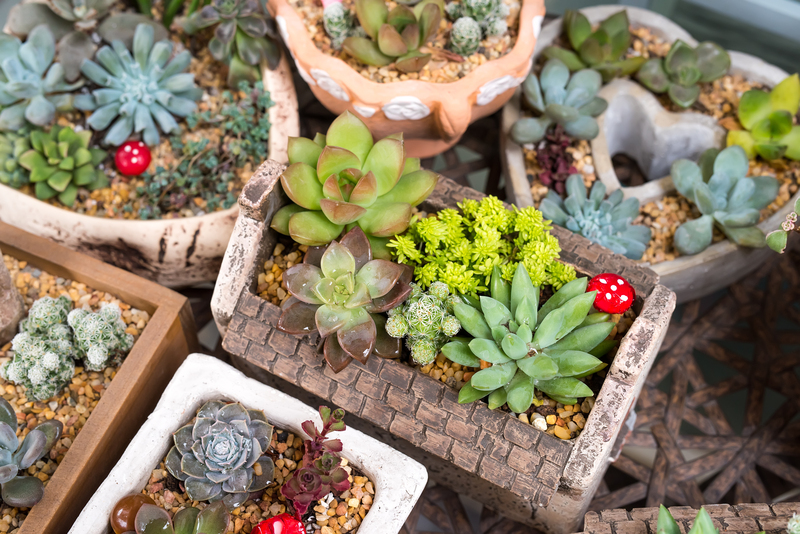Create a Peaceful Zen Garden Sanctuary in Your Backyard
Posted on 18/09/2025
Create a Peaceful Zen Garden Sanctuary in Your Backyard
Are you dreaming of transforming your yard into a tranquil retreat? With busy lives and constant noise, it's more important than ever to have a personal space for *serenity and mindfulness*. Creating a Zen garden sanctuary in your backyard can turn your outdoor area into a haven of calm. Whether you have a spacious lawn or a small patio, learn how to design a peaceful oasis with our comprehensive guide to Zen-inspired landscaping ideas.

What Is a Zen Garden?
Zen gardens, also known as Japanese rock gardens or "karesansui," originated in Japan and are designed to aid meditation and contemplation. Unlike traditional gardens filled with plants and flowers, Zen gardens feature minimalistic elements - rocks, gravel, sand, and carefully chosen plants. Their purpose is to evoke the essence of nature while encouraging peace, balance, and mindfulness.
- Minimalism: Zen gardens utilize simplicity to foster clarity and relaxation.
- Symbolism: Every element, from rocks to sand, represents natural features like mountains and rivers.
- Meditative: The act of raking the gravel or sand helps promote a meditative state.
Benefits of Creating a Backyard Zen Garden Sanctuary
Designing a peaceful Zen garden sanctuary in your backyard provides more than just visual appeal. Here's how a Zen garden can enhance your daily life:
- Stress Relief: Spending time in nature, even a carefully crafted corner of your yard, has been proven to reduce anxiety.
- Mindfulness Practice: Zen gardens are tailored for meditation, promoting focus and inner peace.
- Low Maintenance: Compared to traditional gardens, Zen gardens require less maintenance--no mowing or heavy weeding required.
- Year-Round Beauty: With stones and evergreen elements, your Zen sanctuary remains soothing throughout the year.
- Improved Aesthetics: A Zen retreat elevates your backyard's design and provides instant curb appeal.
Key Elements of a Zen Garden Sanctuary
Creating a Zen-inspired backyard sanctuary means thoughtfully combining natural materials. Here's what to include:
1. Rocks and Pebbles
- Rocks represent mountains or islands and are central to Zen garden design.
- Pebbles or gravel symbolize water; raked patterns mimic the flow and ripple of streams.
2. Sand
Use fine sand or crushed granite as the underlying surface. Raking the sand into circular or flowing patterns signifies waves or tranquility.
3. Carefully Selected Plants
- Evergreens such as Japanese black pine, juniper, or dwarf pines foster a sense of year-round calm.
- Moss is often used for ground cover, enhancing the garden's lushness and serenity.
- Bamboo and ornamental grasses add delicate movement and sound.
- Avoid bright flowers: The focus is on calm variation in texture and green shades.
4. Water Features
While classic dry Zen gardens don't use real water, many backyard Zen sanctuaries include small ponds, trickling fountains, or stone basins to introduce the soothing sounds of water and attract wildlife.
5. Pathways and Stepping Stones
Winding stone paths or stepping stones let you wander through your peaceful Zen retreat. Their irregular shape and placement invite mindfulness and reflection with each step.
6. Simple Ornaments and Structures
- Lanterns: Stone lanterns add beauty and a sense of tradition.
- Benches: Provide a spot to pause, meditate, or enjoy the scenery.
- Bridges: Symbolize the journey of life and can be included over dry stream beds or between sections.
Step-by-Step Guide: How to Create a Zen Garden Sanctuary in Your Backyard
1. Choose Your Location
Identify a quiet, semi-private area in your yard. Consider views from the house and how sunlight and shade move through the day.
- Size doesn't matter: Even a small corner can become a calming oasis.
- Privacy: Use fences, bamboo screens, or tall shrubs to block outside distractions.
2. Plan Your Layout
Sketch your garden's design. Balance open space with clusters of rocks and plants. In traditional Zen garden style, asymmetry and negative space are valued--avoid making it overly symmetrical.
- Start with a focal point such as a large rock or a water feature.
- Arrange secondary rocks, gravel beds, and plants around the central feature to create flow and interest.
- Mark out the borders with stone edging or bamboo fencing.
3. Prepare the Ground
- Remove grass, weeds, and debris from the area.
- Level the soil and lay down landscaping fabric to prevent weeds.
- Add a layer of sand or crushed granite to create the base.
4. Place Rocks, Stones, and Sand
- Set large rocks first, partially burying them for a natural effect.
- Fill around them with gravel or sand, smoothing the base surface.
- Use a rake to create flowing, swirling patterns--a meditative and visually appealing process.
5. Add Minimalist Plants
Individually place evergreens, mosses, bamboo, and sedges to accent but not overwhelm the space. Position plants in odd-numbered clusters for more organic appeal.
6. Incorporate Water and Accents
- Install a small pond, bubbling fountain, or overflowing water basin, ensuring the sound is gentle and soothing.
- Add stone lanterns, simple statues, or a minimalist bench--but keep decorations understated for a true Zen feel.
7. Create Pathways
- Lay natural stone or wooden stepping stones through the garden, letting the path meander naturally.
- Each step should feel intentional, encouraging slow movement and reflection.
8. Extra Touches for Tranquility
- Install subtle, warm outdoor lighting to extend use into the evening.
- Add wind chimes, a bamboo water spout (*shishi-odoshi*), or gentle bells for soothing sounds.
- Hang a hammock or outdoor meditation swing, if space allows.
Essential Zen Garden Maintenance Tips
A key benefit of a backyard Zen garden sanctuary is its low maintenance requirements. Regular attention, however, will keep your haven looking pristine and inviting:
- Rake gravel or sand: Regularly refresh the patterns to keep the surface neat and facilitate meditative practice.
- Weed control: Remove weeds promptly to preserve the minimalist look.
- Prune thoughtfully: Keep shrubs and evergreens shaped but natural.
- Check water features: Clean filters and adjust water levels as needed to prevent algae.
- Seasonal updates: Remove fallen leaves and refresh mulch or sand annually.
How to Meditate in Your Zen Garden Sanctuary
With your serene Zen garden sanctuary created, make the most of it by practicing mindfulness and meditation daily:
- Find a comfortable spot, such as a bench, flat stone, or even the ground.
- Close your eyes, focus on your breath, or watch the play of sunlight and shadows.
- Use a rake to create new patterns in the sand as a moving meditation.
- Practice walking meditation on the pathways, paying close attention to each step.
- Listen to the sounds: trickling water, rustling bamboo, distant birdsong, or wind chimes.
Meditating in your backyard Zen garden can help center your mind, release stress, and restore your spirit--just minutes from your back door.

Frequently Asked Questions about Backyard Zen Gardens
How much space do I need for a Zen garden sanctuary?
You can create a Zen-inspired sanctuary in as little as a few square feet. Focus on quality of layout and elements rather than size. Even a balcony or rooftop can accommodate a miniature Zen garden.
What are the best plants for a peaceful Zen garden?
- Japanese maple (for color and elegance)
- Mondo grass, ferns, mosses
- Dwarf conifers, bamboo, and azaleas
Can I add color to a Zen garden?
While Zen gardens emphasize shades of green and neutral tones, subtle accents--like the red leaves of a Japanese maple or the deep blue of a ceramic water bowl--can enhance the calming atmosphere without overwhelming it.
Do Zen gardens attract wildlife?
Yes. The sound of water, shelter of rocks, and selection of native plants can invite birds, butterflies, and small animals, making your sanctuary feel alive yet tranquil.
How can I personalize my Zen garden sanctuary?
- Add artwork, calligraphy stones, or wind chimes that resonate with you.
- Place a meditation cushion or yoga mat for personal practice.
- Incorporate a favorite stone or object as a hidden focus.
Conclusion: Transform Your Backyard with a Zen Garden Sanctuary
A peaceful Zen garden sanctuary in your backyard is more than an attractive landscaping project--it's a long-term investment in your mental and physical well-being. By integrating natural materials, mindful design, and calming sounds into your outdoor space, you can create a restorative retreat that's always within reach. Explore the world of serene Zen gardens and bring harmony, beauty, and tranquility to your everyday life.
- Embrace simplicity and balance in your backyard escape.
- Choose meaningful materials and layouts to encourage relaxation.
- Maintain your Zen sanctuary as a personal place for mindfulness and renewal.
Ready to find inner peace at home? Start planning your backyard Zen garden sanctuary today and experience the enduring beauty of Zen landscaping--right outside your door.



